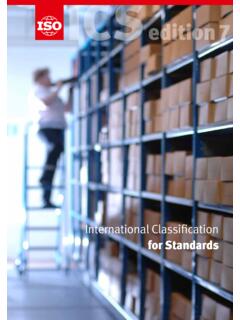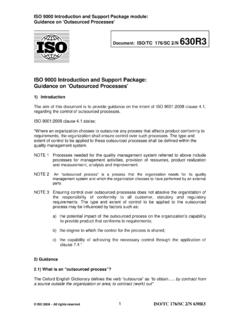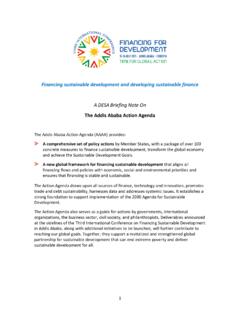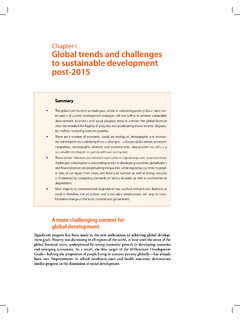Transcription of Contributing to the Sustainable Development Goals with …
1 &SDGsContributing to the UN Sustainable Development Goals with ISO standardsContributing to the UN SDGs with ISO standards | 1 Transforming our world is the aim of the United Nations 2030 Agenda for Sustainable Development and its corresponding 17 Sustainable Development Goals (SDGs).This ambitious action plan to enhance peace and prosperity, eradicate poverty and protect the planet is recognized globally as essential for the future sustainability of our world. It calls on the contribution from all elements of society, including local and national govern-ments, business, industry and be successful, the process requires consen-sus, collaboration and innovation. ISO has published more than 22 000 International Standards and related documents that rep-resent globally recognized guidelines and frameworks based on international collabo-ration.
2 Built around consensus, they provide a solid base on which innovation can thrive and are essential tools to help governments, industry and consumers contribute to the achievement of every one of the brochure gives an overview of how they achieve that, and provides a snapshot of just some of the key standards that could be use-ful to can benefit from using ISO International Standards ?Government Regulators can rely on ISO standards as a solid base on which to create public policy that helps further SDG Goals such as human rights, water and energy efficiency, public health, and more. Recognized the world over, International Standards also help governments achieve their national and international Industry plays a key role in achieving all the SDGs and ISO standards help it do that by providing guidelines and frameworks on everything, from employee health and well-being to energy consumption, to resilient and eco-friendly While Contributing to the SDGs ranks high on the agenda of business leaders and politicians, many of the benefits are felt at the local community level.
3 Reduced poverty, improved health, cleaner and more abundant water, and safe and secure infrastructures are just some of the benefits to be gained from implementing ISO | Contributing to the UN SDGs with ISO standardsContributing to the UN SDGs with ISO standards | 3 ISO standards support the three pillars of Sustainable developmentEconomicISO International Standards promote economic sustainability by facilitat-ing international trade, improving a country s national quality infrastruc-ture 1) and supporting Sustainable business practices. 1) A quality infrastructure is a system Contributing to governmental policy objectives in areas includ-ing industrial Development , trade competitiveness in global markets, efficient use of natural and human resources, food safety, health, the environ- ment and climate change.
4 (Source : UNIDO)They cover everything from efficient farming methods to anti-bribery man-agement International Standards promote social sustainability by helping coun-tries and communities to improve the health and well-being of their citi-zens. They cover all aspects of social welfare, from healthcare systems and related products to social inclusion and International Standards pro-mote environmental sustainability by helping businesses and coun-tries manage their environmental impact. They cover such aspects as implementing an environmen-tal management system, measur-ing and reducing greenhouse gas emissions and energy consump-tion, and encouraging responsible informationISO Website : magazine : videos : us on Twitter : us on Facebook : us on GooglePlus : 26000, Guidance on social responsibilityA Sustainable future means balancing the needs of the envi-ronmental, social and economic systems, and organizations are increasingly expected to play a significant role in achieving this.
5 With over 450 recommendations that directly impact the SDG Goals , ISO 26000 provides guidance on how businesses and organiza-tions can operate in an ethical and transparent way that contributes to Sustainable to the UN SDGs with ISO standards | 5 SDG 1 No povertyEnd poverty in all its forms everywhereBy providing a platform for best practice in all areas of economic activity, from agriculture to banking, ISO International Standards contribute to the Sustainable production of food and resources as well as Sustainable example, ISO 20400, Sustainable procurement Guidance, helps organi-zations develop Sustainable and ethical purchasing practices that also benefit the societies in which they operate.
6 It includes guidelines for implementing ethical processes throughout the sup-ply 37001, Anti-bribery management systems Requirements with guidance for use, supports business and govern- ment in their efforts to build integrity and combat bribery. By instilling an anti-bribery culture within organiza-tions, it helps reduce the large gaps in wealth that are a major cause of poverty in many countries around the | Contributing to the UN SDGs with ISO standardsContributing to the UN SDGs with ISO standards | 7 SDG 2 Zero hungerEnd hunger, achieve food security and improved nutrition and promote Sustainable agricultureISO has over 1 600 standards for the food production sector designed to create confidence in food products, improve agri-cultural methods and promote Sustainable and ethical purchas-ing.
7 They also cover a number of other areas including nutritional and safety testing, quality, pack-aging, and specifically on the food sector, the ISO 22000 fam-ily of standards on food safety management helps organiza-tions identify and control food safety hazards, while related standards such as ISO 26000 (social responsibility) and ISO 20400 ( Sustainable pro-curement) encourage socially responsible behaviour and ethical working conditions for agricultural workers and pro-mote ethical purchasing prac-tices throughout the entire food production in Development , the ISO 34101 series of standards on Sustainable and traceable cocoa beans will specify requirements for a management system in cocoa bean farming.
8 It provides a set of guidelines for environ-mentally sound agricultural practices, the enhanced trace-ability of cocoa beans and for improving the social conditions and livelihoods of farmers and all those involved in the cocoa supply | Contributing to the UN SDGs with ISO standardsContributing to the UN SDGs with ISO standards | 9 SDG 3 Good health and well-beingEnsure healthy lives and promote well-being for all at all agesAccess to quality healthcare is an essential human right. ISO has over 1 300 standards supporting safe, qual-ity medical practices and equipment that help healthcare providers deliver a more reliable and effective service. These include standards on steriliza-tion methods, medical devices, surgical implants and instruments, health infor-matics and related products, among other areas of focus.
9 Notable examples are the ISO 11137 series for the steriliza-tion of healthcare products by radiation and ISO 7153 on materials for surgical also develops standards to help local governments promote health and well-being in their communities, such as International Workshop Agree- ment I WA 18, Framework for integrated community-based life-long health and care services in aged societies, and ISO 37101 for the Sustainable develop - ment of | Contributing to the UN SDGs with ISO standardsContributing to the UN SDGs with ISO standards | 11 SDG 4 Quality educationEnsure inclusive and equitable quality education and promote lifelong learning opportunities for allRecognizing the importance of quality education for all, ISO is developing 2) ISO 21001, Educational organizations Management systems for educational organizations Requirements with guid-ance for use, the first ever management system standard on education.
10 It is aimed at improving the processes and quality of educational institutions to address the needs and expectations of those who use their addition, ISO s technical committee ISO/TC 232 develops standards that describe the requirements for learn-ing services provided outside formal education, such as ISO 29993, which covers all types of lifelong learning including vocational education and in-company training (either outsourced or in-house).2) Due to be published in | Contributing to the UN SDGs with ISO standardsContributing to the UN SDGs with ISO standards | 13 SDG 5 Gender equalityAchieve gender equality and empower all women and girlsGender equality is a key com-ponent of social responsibil-ity, and the empowerment of women and their equality in society is underlined in ISO 26000, Guidance on social responsibility.












